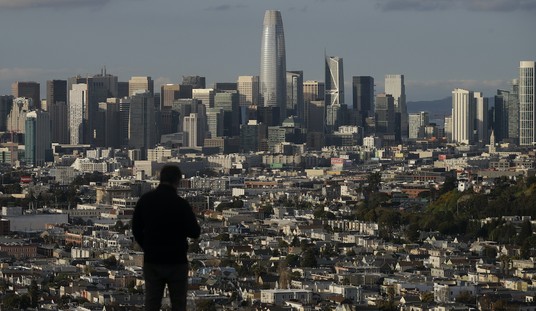Yes, it’s bad, but as with the initial Q1 estimate, this just gives a taste of what’s to come. The COVID-19 shutdown in the final three weeks of the first quarter turned a growing economy into a -5% annualized GDP drop, slightly worse than the -4.8% in the initial estimate. Worse still are the continuing jobless claims numbers, to which we’ll get in a moment:
Real gross domestic product (GDP) decreased at an annual rate of 5.0 percent in the first quarter of 2020 (table 1), according to the “second” estimate released by the Bureau of Economic Analysis. In the fourth quarter, real GDP increased 2.1 percent.
The GDP estimate released today is based on more complete source data than were available for the “advance” estimate issued last month. In the advance estimate, the decrease in real GDP was 4.8 percent. With the second estimate, a downward revision to private inventory investment was partly offset by upward revisions to personal consumption expenditures (PCE) and nonresidential fixed investment (see “Updates to GDP” on page 2). …
Real gross domestic income (GDI) decreased 4.2 percent in the first quarter, in contrast to an increase of 3.1 percent (revised) in the fourth quarter. The average of real GDP and real GDI, a supplemental measure of U.S. economic activity that equally weights GDP and GDI, decreased 4.6 percent in the first quarter, in contrast to an increase of 2.6 percent in the fourth quarter (table 1).
Current‑dollar GDP decreased 3.5 percent, or $191.6 billion, in the first quarter to a level of $21.54 trillion. In the fourth quarter, GDP increased 3.5 percent, or $186.6 billion (tables 1 and 3).
Income dropped, but prices rose — a combination that will further squeeze consumer spending, even if joblessness doesn’t:
The price index for gross domestic purchases increased 1.7 percent in the first quarter, compared with an increase of 1.4 percent in the fourth quarter (table 4). The PCE price index increased 1.3 percent, compared with an increase of 1.4 percent. Excluding food and energy prices, the PCE price index increased 1.6 percent, compared with an increase of 1.3 percent.
PCEs fell by 6.8%, an astounding number based on only three or so weeks of shutdown, and even then not in all areas of the country. There’s not much point in going through the rest of the numbers, as they are uniformly bad, but imports (-15.5%) stunk a lot more than exports (-8.7%). That actually adds to GDP, so it could have been a lot worse, at least theoretically. It also suggests that our trading partners are struggling more, probably mostly China, which is a target for administration trade policies anyway.
Unfortunately, we are about to see what will happen when three weeks gets extended for three months. Thus far, we still have not stanched the flow of joblessness, as another 2.1 million people filed first-time claims last week. That’s down again from the week before, but it puts cumulative first-time jobless claims at over 40 million in this pandemic. The only potentially good news from this report is that some of those might have gone back to work over the last couple of weeks, emphasis mine:
In the week ending May 23, the advance figure for seasonally adjusted initial claims was 2,123,000, a decrease of 323,000 from the previous week’s revised level. The previous week’s level was revised up by 8,000 from 2,438,000 to 2,446,000. The 4-week moving average was 2,608,000, a decrease of 436,000 from the previous week’s revised average. The previous week’s average was revised up by 2,000 from 3,042,000 to 3,044,000.
The advance seasonally adjusted insured unemployment rate was 14.5 percent for the week ending May 16, a decrease of 2.6 percentage points from the previous week’s revised rate. The previous week’s rate was revised down by 0.1 from 17.2 to 17.1 percent. The advance number for seasonally adjusted insured unemployment during the week ending May 16 was 21,052,000, a decrease of 3,860,000 from the previous week’s revised level. The previous week’s level was revised down by 161,000 from 25,073,000 to 24,912,000. The 4-week moving average was 22,722,250, an increase of 760,250 from the previous week’s revised average. The previous week’s average was revised down by 40,250 from 22,002,250 to 21,962,000.
That generally jibes with reopening efforts in some states, so this could be a phenomenon of reopening. If so, that’s welcome news, and at least some indication that we could see a rapid rebound once governments stop restricting public squares, or at least roll back the heavier restrictions. Some of that will be dependent on whether consumers feel comfortable in returning to commerce, but government regulations do tend to be economic signals, too.
What can we expect from Q2’s assessment? Based on this, it’s clearly going to be really really bad, but the situation is so unprecedented that it’s tough to make any predictions. That might explain why the Trump administration has broken with precedent and opted not to issue formal economic projections at the beginning of summer, although the Washington Post focuses on other motives:
White House officials have decided not to release updated economic projections this summer, opting against publishing forecasts that would almost certainly codify an administration assessment that the coronavirus pandemic has led to a severe economic downturn, according to three people with knowledge of the decision.
The White House is supposed to unveil a federal budget proposal every February and then typically provides a “mid-session review” in July or August with updated projections on economic trends such as unemployment, inflation and economic growth.
Budget experts said they were not aware of any previous White House opting against providing forecasts in this “mid-session review” document in any other year since at least the 1970s.
Two White House officials confirmed the decision had been made not to include the economic projections as part of the mid-session release. The officials, who spoke on the condition of anonymity to discuss internal deliberations, said that the novel coronavirus is causing extreme volatility in the U.S. economy, making it difficult to model economic trends.
Well, yeah. No one doubts that Q2’s numbers will be bad on an entirely new and historical plane of existence, but even that can’t be modeled reliably at the moment, let alone Q3 or Q4. There are far too many unknowns involved right now: governors’ shutdown policies, COVID-19 waves, vaccine trials, consumer psychology in a pandemic, and so on. We haven’t had a situation like this in a century, back when our economy was far more agrarian and far less service-oriented, so it shouldn’t exactly surprise anyone that modelers might want to take a wait-and-see attitude.
Perhaps by the end of summer, we can get a better handle on all of these new variables and get a predictive model worth using. Until then, we can just say this — it’s gonna be bad, and it’s gonna be bad for a while.








